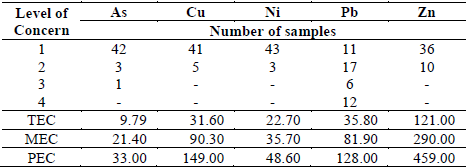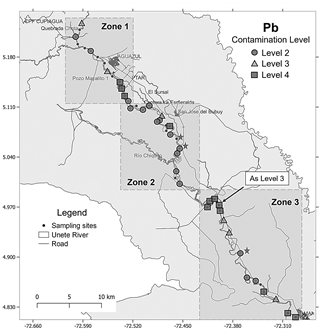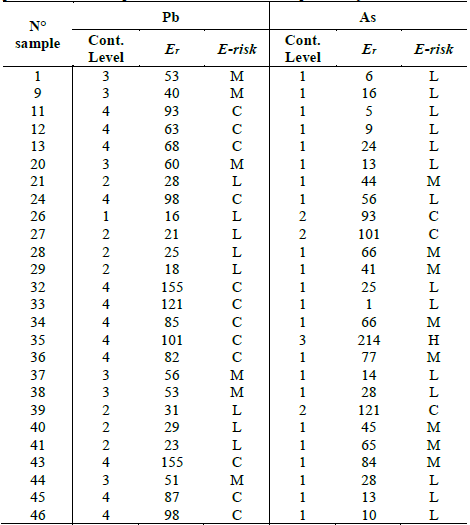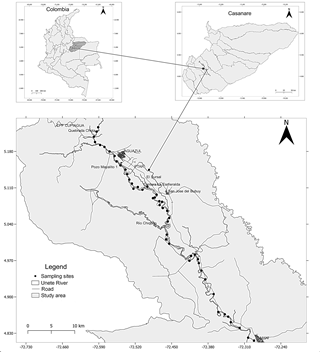1. Introduction
Heavy metals (HM) are a group of metals and metalloids that have relatively high density and are toxic even at ppb levels [1]. Studying the behavior of these elements in water bodies provides information about their possible ecological risks. Heavy metals are naturally present in soil and water, and under normal conditions, these metals do not present any harmful effects on the ecosystem because they are geogenic in nature [2-5]. The sediments of water bodies act as carriers of possible sources of contamination, which can induce changes in pH, redox potential, dissolved oxygen, and electrical conductivity. For this reason, the analysis of the heavy metals concentrations in sediments is an appropriate measure to determine the possible contamination levels in water bodies [2-6]. Anthropogenic activities can alter the natural HM concentrations with significant negative implications on ecosystems in the short- and long-term. Accelerated industrialization, rapid population growth, and agricultural activities have led to the generation of chemical anomalies in the various water resources worldwide [6-11]. In Colombia, the mining activities have been one of the sources with the greatest contribution of pollutants in the tributaries [12-14]. The department of Casanare (Colombia) is characterized by the oil and gas extraction, large agriculture activity and a large population growth, all of which have increased the possibilities of contamination of water sources in the region. To the best of our knowledge, there have been no studies regarding the heavy metal concentrations in rivers of Casanare (Colombia).
This paper presents the detection and analysis of heavy metals concentrations of Arsenic (As), Copper (Cu), Nickel (Ni), Lead (Pb) and Zinc (Zn) in surface sediments of the Unete River as well as their possible toxicity level, using the sediment quality guidelines (SQGs) and the classification of potential ecological risk proposed by Hakanson [15], this with the aim of presenting a first description of the environmental conditions of this important water source. This river is one of the most important rivers of the municipalities of Aguazul and Mani (Casanare-Colombia).
2. Material and methods
2.1. Study area and sampling sites
The Unete River micro-basin is located in the central part of the Cusiana River basin. The river traverses the municipality of Aguazul and part of the municipality of Mani in the department of Casanare (Colombia). It originates in the department of Boyacá (Colombia), between the Paraiso and Mirador Mountain ranges at 1300 m.a.s.l., at the confluence of the Cascada, San Juan and Minquirá streams. Its hydrographic basin has an area of 943.280 km2 and a length of 95 km to its mouth in the Cusiana River [16]. The study area and sampling sites are presented in Fig.1.
2.2. Sediment sampling
An exploratory sampling was carried out during in dry season (March 2019) and was based on the protocol of the Colombian Geological Service, whereby surface sediments (0-10 cm) were obtained from 46 sampled sites distributed along the 92 km of the Unete river from the initial sampling point at the site called Puente vía al pozo Cupiagua S, at geographical coordinates of latitude 5.2266 and longitude -72.5916 and at an altitude of 375 m.a.s.l., to the final point at geographic coordinates of latitude 4.8214 and longitude -72.3029 and an altitude of 172 m.a.s.l (Fig.1). Each sample obtained consists of three homogenized subsamples within a radius of 10 m. The sampling strategy was carried out according to the procedure suggested by Shelton and Capel [17], which focuses on obtaining samples of fine-grained superficial sediments from natural depositional zones during low-flow conditions and on compositing samples from several depositional zones within a stream reach. This strategy is designed to yield a representative sample of fine-grained superficial bed sediments [17]. The samples collected were refrigerated and dried at 40° C (± 1°). Once a constant weight was obtained, the sample was crushed with a porcelain mortar and then sieved in a 200 mesh with a diameter of 57 µm, after which they were stored in polyethylene bags for later analysis.
2.3 Physical-chemical analysis
The physical and chemical variables (pH and conductivity) of the sediments from each sampling site were measured in situ and triplicate using a pH Meter Handy lab and Hanna HI8733 conductivity meter, respectively. Organic mater content was measured using loss on ignition method.
2.4. Determination of metals
For the measurement of total metal concentrations, acid digests of each sediment sample were prepared using USEPA method 3050B) [18]. Total metal concentrations of As, Cu, Ni, Pb and Zn were determined in triplicate using Shimadzu Atomic absorption spectrophotometry (model AA7000) at Grupo de Catálisis laboratory (UPTC), Colombia. The results presented are average values from three measurements, and the relative standard deviation of all replicate samples was < 10%.
2.5. Potential ecological risk index
The potential ecological risk index (E r ) [15] was used to assess the comprehensive potential ecological risk of heavy metals in sediment. The E r of a given metal is defined as:
where, C is the metal concentration measured in surface sediments, C
BV
is the background value for each element, and T
r
is the biological toxicity factor. The ecological risk index (RI) due to the joint presence of the heavy metals was calculated as
 . This is the comprehensive potential ecological risk index of the metals. The E
r
of heavy metals was categorized according to five levels suggested by Hakanson [15].
. This is the comprehensive potential ecological risk index of the metals. The E
r
of heavy metals was categorized according to five levels suggested by Hakanson [15].
3. Results and Discussion
3.1. Properties of surface sediments
Physicochemical analysis showed that sediment samples have a pH range from 5.24 to 8.65 with a mean of 7.16. This means that the water environment is slightly alkaline, a condition that allows the mobility of heavy metals, preventing their accumulation [19, 20]. The electrical conductivity (EC) measurements were shown to be in the range from 0.10 to 1.82 mS/cm with a mean of 0.75 mS/cm which is within the limits allowed for the proper functioning of a water body [21]. Additionally, the organic mater (OM) in the sediment samples was found to be in the range from 1% to 18% with an average of 3%, which, according to Saikia et al. [22] fall within the natural range.
Table 1 shows the limit and the mean concentration values of heavy metals (in mg/kg) measured in surface sediments of the Unete River. It was observed that the mean values of the As, Pb and Zn concentrations are significantly above the background value (BV). An analysis of the enrichment factor (EF) for these three heavy metals confirmed that their concentrations are due to anthropic processes. The maximum concentrations of the metals evaluated were above the threshold effect concentrations (TEC), defined in the consensus-based sediment quality criteria guidelines (SQGs) [24], while the mean value of Pb concentrations was the one above the TEC. This means that in some of the sampled sites, there could be adverse effects on the environment due to the presence of these elements.
Table 1 Heavy metals concentrations in mg/kg measured in surface sediments from Unete river. Background values (BV) [23] and Threshold effect concentration (TEC) from the consensus-based Sediment quality criteria guidelines (SQGs) for heavy metals in freshwater ecosystems suggested by MacDonald et al. [24] are also presented.

Source: Authors.
Table 2 Number of samples at each level of concern identified for the heavy metal concentrations (cHM) measured in surface sediment of the Unete River. TEC and PEC values (in mg/kg) from ref. [24]. MEC values are the average between PEC and TEC values.

Level 1: cHM < TEC. Level 2: TEC ≤ cHM < MEC. Level 3: MEC ≤ cHM < PEC. Level 4: cHM ≥ PEC.
Source: Authors.
The SQGs include a threshold effect concentration (TEC) and a probable effect concentration (PEC). Below the TEC, adverse biological effects are rarely expected to occur, whereas the PEC is defined as the level above which adverse biological effects are expected to occur more often than not [25]. The measured concentrations were compared to the three thresholds (TEC, MEC and PEC) to indicate the level of concern. The contaminant concentration levels are rated as 1, 2, 3, or 4, with Level 1 being the least concerning and Level 4 the most [24], where the MEC is the midpoint effect concentration between the TEC and PEC.
Table 2 shows the levels of concern based upon the concentrations of heavy metal measured in surface sediment samples of the Unete River. It was observed that As, Cu, Ni and Zn concentrations are mainly at Levels 1 and 2, with an As concentration (23.6 mg/kg) at Level 3. In the case of Pb concentrations, 11 sampled sites report having Pb concentrations at Level 1 along with 17 at Level 2, which still might not yet represent an adverse effect on the environment. However, 6 sites report Pb concentrations that are near to the PEC (Level 3), and 12 sites above the PEC (Level 4). The sampled sites with a Level 4 concern have a concentration range of 131.9 - 324,7 mg/kg with a mean of 216,9 mg/kg (89 mg/kg above the PEC), while those at Level 3 have a concentration range of 83.7 - 126.9 7 mg/kg, with a mean of 109.8 mg/kg (18.4 mg/kg below the PEC). The contamination by Pb is probable in 26% of the sampled sites (46).
Three zones were established in the study area to facilitate the description of geographic spatial distribution of the levels of concern for the As and Pb concentrations (see Fig. 2). Zone 1 (upper part in Fig. 2) has five sites with concerning Pb concentrations, especially considering that the three at Level 4 and one at Level 3 are contiguous and located near to Aguazul and its residual water treatment plant, reaching dangerous Pb concentrations up to 195.3 mg/kg with a mean of 132.9 mg/kg. However, this zone is the one with the largest number of sampled sites at Level 1. Zone 2 (middle part in Fig. 2) shows two sampled sites which are near to San Jose del Bubuy with Pb concentrations at Levels 3 (126.9 mg/kg) and 4 (205.5 mg/kg), respectively. However, most of the sampled sites in this zone report having a contamination Level 2 (2 of As and 7 of Pb). This means that these are slightly above the TEC, while the other five are below it.

Source: Authors.
Figure 2 As and Pb contamination level distributions in surface sediments from Unete River. The stars indicate As concentrations at Level 2.
Zone 3 (lower part in Fig. 2) is the one that shows the higher number of sampled sites with concerning Pb concentrations. It has a total of eight sites at Level 4 with a Pb concentration range of 177.6 - 324.7 mg/kg and a mean of 240.9 mg/kg along with three sites at Level 3 with a mean of 111.8 mg/kg. Of all the sites at Level 4, five are continuous in the upper part of the Zone 3 (near the intersection of two main roads, which are very close to the river), while the other three are in the lower part of the Zone 3 (near the main road on the way to Maní). The Pb concentrations at Level 3 are contiguous with those at Level 4, and the ones at Level 2 are in the middle part of the Zone 3, with one of these mentioned sites having an As concentration at Level 2. As far as we know, the expanse shown in the righthand part of Zone 3 is used for agriculture, which along with the proximity to the main roads of the zone could be the cause of the concerning concentrations of Pb and As.
In Colombia, studies of heavy metal pollution in the Magdalena [14] and Cauca [13] rivers, and the Gulf of Urabá [26] have been reported in the literature. In these water sources the significant presence of Pb and As, associated with mining mainly, has also been reported. However, to the best of our knowledge, no study of this nature in rivers of the Colombian Orinoquia region has been published. This region is characterized for oil exploitation, livestock, and agriculture (rice and palm oil crops).
3.2. Ecological risk assessment
In order to validate and consolidate the previous results, the potential ecological risk index E r [15] was determined for the As and Pb concentrations in each of the sampled sites using the background (C BV ) and biological toxicity factor (T r ) values reported in references [23] and [24], respectively. These results were categorized according to the potential ecological risk degrees (E-risk) suggested by Hakanson [15]; Low, Medium, Considerable, High, and Very high. Table 3 shows the E r values calculated along with the respective E-risk compared with the levels of concern from Table 2.
In Table 3, it is observed for Pb that in the sites where a Level 4 was identified, an E r value associated with a considerable (C) potential ecological risk degree (E-risk) was consequently determined, while for Levels 3 a moderate (M) E-risk was assigned, and for Levels 1 and 2, a low (L) potential ecological risk. In the case of As, Levels 3 and 2 were correlated with a high (H) and considerable (C) environmental risk degree, respectively. Some sampled sites that were identified at contamination Level 1 were associated with a moderate (M) ecological risk. These results (As) are possibly due to two reasons: The first one is the high degree of toxicity of As (greater than Pb). The second one is that for some of these of the sampled sites, As concentrations were measured at the upper limit of Level 1, (i.e., very close to Level 2). Although the ecological risk degree due to the presence of As is high in one of the sampled sites, the distribution of the ecological risk induced by the presence of Pb in the studied section of the Unete River, especially in Zone 3, is greater than that of As. Regardless, all of these results are ecologically concerning. The ecological risk degree created by Ni, Zn and Cu was calculated for completeness, and it was determined that given their.
Table 3 Index E r and potential ecological risk degree E-risk associated with the presence of Pb and As in surface sediments of the Unete River. These parameters are compared with levels of concern previously described.

L: Low E r < 40; M: Moderate 40 ≤ E r < 80; C: Considerable 80 ≤ E r < 160; H: High 160 ≤ E r < 320; Vh: Very high E r ≥ 320 are the potential ecological risk degrees (E-risk) suggested by Hakanson [15]. For the other sampled sites, the Pb concentrations with contamination levels 1 and 2, the E-risk is always Low, while for As concentrations with level 1 E-risk is always Low.
Source: Authors.
concentrations in all of the sampled sites, these warrant a low (L) ecological risk degree. In order to establish the ecological risk index (RI) due to the presence of the analyzed heavy metals (As, Pb, Ni, Cu and Zn) in each of the sampled sites, the RI index was calculated using
 . It was found that seven of the 46 sampled sites present a moderate (M) ecological risk (150 < RI < 300 [15]), six of which are located in Zone 3 with one in Zone 2. All other ones present a low (L) ecological risk (150 > RI [15]). The site with moderate ecological risk in Zone 2 is located relatively close to San José del Bubuy (it is the only one in Zone 2 of Fig.3 with Pb at Level 4).
. It was found that seven of the 46 sampled sites present a moderate (M) ecological risk (150 < RI < 300 [15]), six of which are located in Zone 3 with one in Zone 2. All other ones present a low (L) ecological risk (150 > RI [15]). The site with moderate ecological risk in Zone 2 is located relatively close to San José del Bubuy (it is the only one in Zone 2 of Fig.3 with Pb at Level 4).
The six sites with moderate (M) potential ecological risk in Zone 3 are located in 3 sectors: the first (with 4 sites) in the upper part of Zone 3, significantly close to the intersection of two important roads in that zone; the second one is in the center of Zone 3 (the only one of Zone 3 in Fig.2 with As at Level 2), and the third one is located 3 levels below the aforementioned.
4. Conclusions
For the first time, this study analyzed the spatial distribution and ecological risks of heavy metals As, Cu, Ni, Pb, and Zn in surface sediments from Unete River (Casanare-Colombia). It was possible to determine that the metals Cu, Ni and Zn do not represent any environmental risk in any part of the 92 km of the river evaluated; however, critical sites (19) were found with concerning As and Pb concentrations (Levels 3 and 4) according to comparison with the threshold effect concentration (TEC) and a probable effect concentration (PEC) defined in the consensus-based sediment quality criteria guidelines (SQGs). Nevertheless, according to the defined levels of concern, only one of these 19 sites has a significant concentration of As. The sites identified (12) with Pb at concern Level 4 have a concentration range of 131.9 - 324,7 mg/kg with a mean of 216,9 mg/kg, which is 89 mg/kg above PEC. These sites were further identified in the considerable (C) environmental risk degree, which represent 26% of the sampled sites analyzed (46). The sample with the As concentration (23.6 mg/kg) at Level 3 represents a high environmental risk. The determination of the ecological risk index (RI) due to the joint presence of the analyzed heavy metals led to finding that 7 of the 46 sampled sites present a moderate (M) ecological risk. Based on observable coincidental geographic factors, it can be inferred that the possible contamination by Pb and As likely originates from agriculture activities as well as the proximity of the Unete River to the main roads and the urban centers of the study area. The results presented in this study show the need to continue evaluating the heavy metal contamination in this study area as well as to carry out studies to evaluate the possible health risks faced by the inhabitants. These results could be fundamental tools to evaluate aspects of environmental toxicology and risk to human health and serve as a starting point to initiate the implementation of conservation and/or mitigation policies in the study region. Moreover, in order to decrease the uncertainty related to the discrimination between the lithogenic and anthropogenic origins of the target heavy metals, the need for detailed geochemical surveys in the future is also highlighted. These results will provide reference data for future studies of heavy metal pollution in sediment from Unete river and other ones close to it.

















